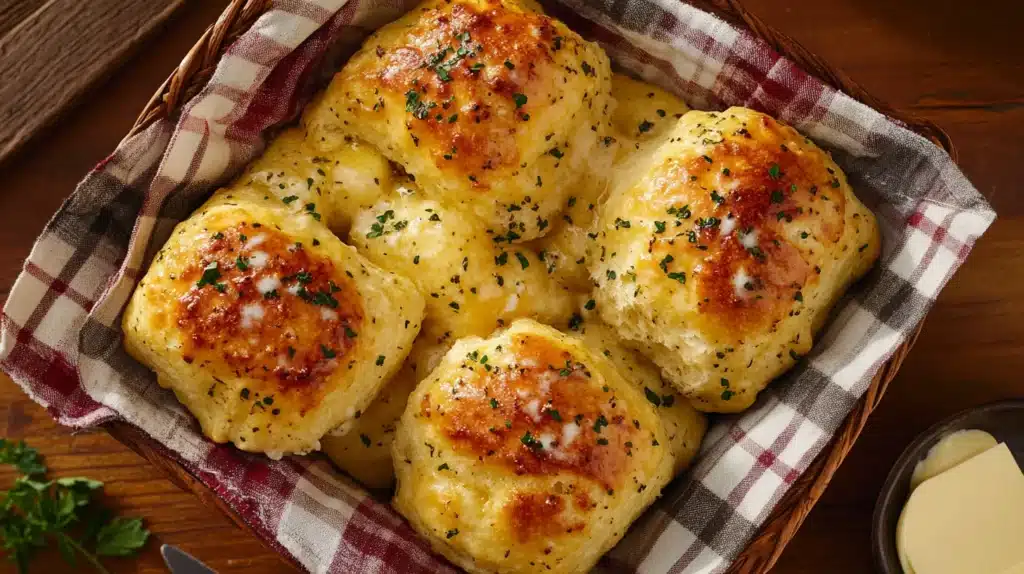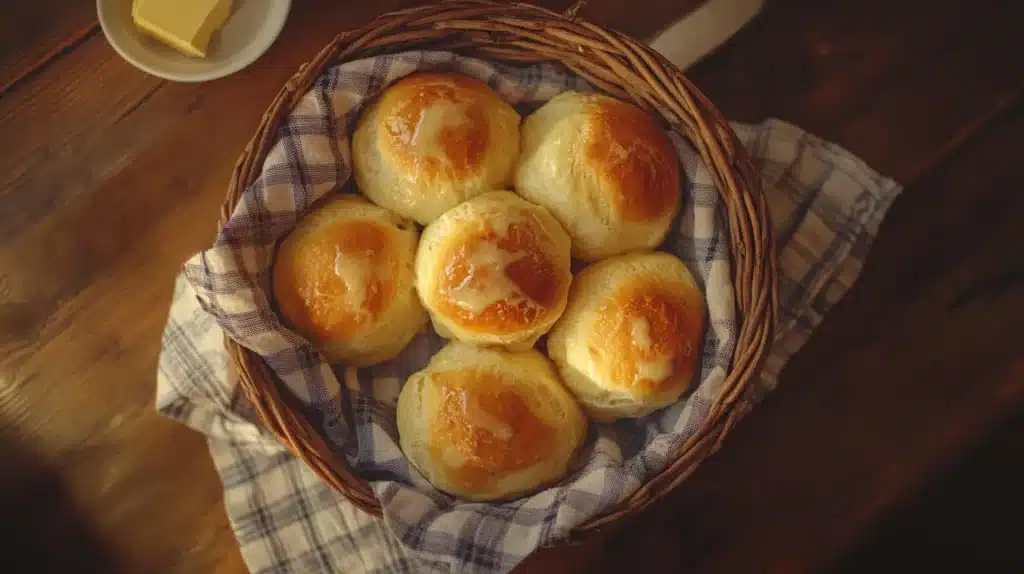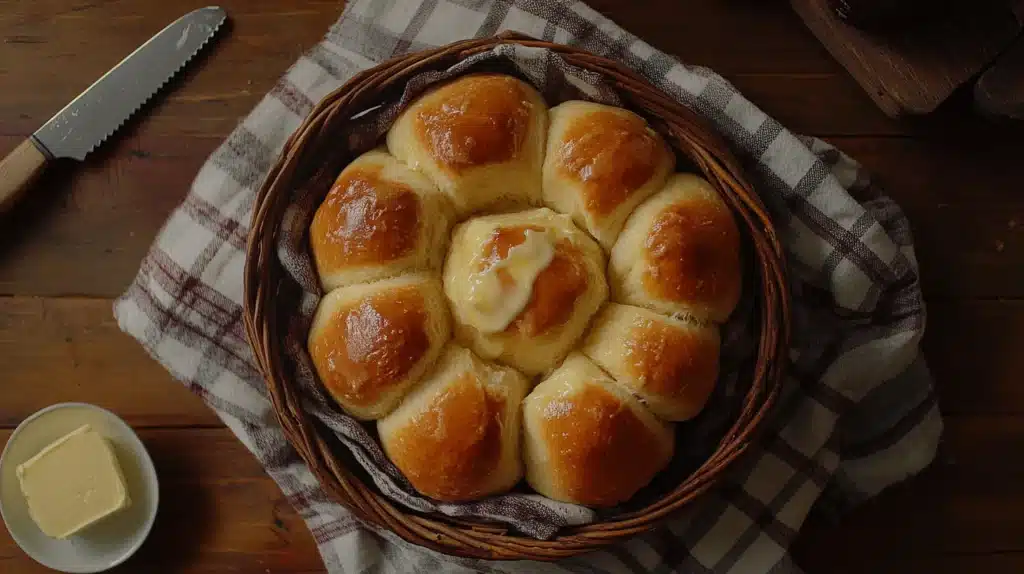Bubba’s Dinner Rolls -Fluffy and Easy Recipe for Any Occasion
If you’re looking for the perfect, soft, and fluffy dinner rolls, Bubba’s Dinner Rolls are the answer! This simple yet delicious recipe ensures a melt-in-your-mouth experience that is sure to impress your guests at any gathering. Whether it’s a family dinner, holiday celebration, or special event, these rolls are the ideal side dish to complement any meal. With just a few ingredients and easy steps, you can have a batch of warm, homemade rolls in no time!
The kitchen fills with memories of family gatherings and holiday feasts when fresh Bubba’s Dinner Rolls rolls bake in the oven.Creating Bubba’s Dinner Rolls has been a long-term project of mine. A simple family favorite turned into a method that never fails.
Dense, uneven rolls can be disappointing, but through my countless test batches, I discovered the exact techniques that make Bubba’s dinner rolls light and fluffy. As a result, these rolls turn out perfectly every time. The secret, however, lies in proper yeast activation and ideal proofing conditions. By paying attention to these key factors, you’ll learn every small detail needed to make these irresistible rolls.
This piece guides you through each step to create these classic dinner rolls. Along the way, you’ll receive professional tips and solutions for common problems, ensuring great results every time. Moreover, the techniques work equally well for both holiday celebrations and casual family dinners. As a result, your home kitchen will produce rolls that rival any bakery’s quality.

The Secret Science Behind Perfect Bubba’s Dinner Rolls
Let’s explore the fascinating science that ensures Bubba’s dinner rolls come out perfectly every time. In fact, I found that there is something truly special about understanding the mechanisms that transform good rolls into exceptional ones. By delving into the science, you gain insight into how each step plays a crucial role in achieving that perfect texture and taste.
Bubba’s Dinner Rolls : Understanding yeast activation and proofing
The magic starts with proper yeast activation. In fact, the sweet spot for yeast activation lies between 110-115°F. Yeast behaves like tiny organisms that need perfect conditions to thrive. Specifically, a combination of warm water, yeast, and a touch of sugar creates that characteristic foamy surface—an unmistakable sign that the yeast is alive and ready to work.
These key indicators signal successful proofing:
- Dough doubles in size
- Gentle finger poke leaves an indentation that slowly springs back
- Surface becomes puffy and jiggles slightly when shaken
Becoming skilled at dough consistency and texture
Developing gluten is essential for achieving the ideal texture. Gluten strands start forming a significant protein network once flour mixes with liquid and mechanical action begins. You need to hit that sweet spot where the dough becomes smooth and elastic without overworking it.
The dough should clear the bowl’s sides while staying slightly tacky (but not sticky) during kneading. This process usually takes 5-8 minutes with a stand mixer or 10 minutes by hand.
Temperature control for optimal results
Temperature plays a vital role at every stage. The proofing environment should stay between 75-85°F with 75-80% humidity. This precise control will give consistent results every time. Starting at a higher temperature of 400°F creates that initial “oven spring” – the secret behind the rolls’ characteristic rise.
An instant-read thermometer is useful for ensuring the internal temperature hits 190°F. This technique guarantees that perfect golden-brown exterior while keeping the inside soft and fluffy.
Bubba’s Dinner Rolls:Essential Equipment and Ingredients for Success
Making perfect Bubba’s dinner rolls starts with the right tools and ingredients in your kitchen. Experience has taught me that quality equipment and ingredients make the most important difference in how your rolls turn out.
Must-have baking tools and alternatives
I have several tools in my kitchen that ensure I achieve consistent results.. Here’s what you need:
- Digital kitchen scale to measure precisely
- Stand mixer with dough hook (or large mixing bowl if you knead by hand)
- Digital thermometer to check liquid temperatures
- Heavy-duty baking pan
- Dough scraper to shape
- Pastry brush to apply butter
Common kitchen items work great as alternatives. For example, a wine bottle can easily replace a rolling pin, and a fine-mesh strainer can do the job of a flour sifter. Additionally, beginners can even use a regular pasta colander to add air to the flour. By using these simple tools, you can still achieve excellent results without needing specialized equipment.
Bubba’s Dinner Rolls:Choosing the right flour and yeast
All-purpose flour works well, but bread flour will raise your rolls to the next level. Bread flour’s higher protein content builds stronger gluten networks that give you better texture.
Active dry yeast is my go-to choice, but it’s important that it’s fresh and not expired. Therefore, you should always test if your yeast is alive. To do this, mix it with warm milk and sugar—it should bubble and foam within five minutes. If nothing happens, however, it’s time to start over with new yeast.
The role of different ingredients
Every ingredient in Bubba’s dinner rolls plays a vital role in creating the perfect texture and taste. For instance, whole milk not only gives superior flavor but also contributes to the texture. The milk’s fat, in particular, helps make the rolls tender, while its protein is responsible for creating that beautiful golden-brown crust. As a result, the combination of these elements ensures a truly exceptional roll.
Butter adds richness and creates that flavor everyone loves. Room temperature ingredients matter a lot. Allow the butter to sit at room temperature for about an hour before starting.
Sugar does double duty – it feeds the yeast and makes everything taste better. Salt does more than add flavor. It controls how the yeast grows and makes the gluten structure stronger. Precise measurements matter because baking is a science.

Bubba’s Dinner Rolls:Step-by-Step Mixing and Kneading Techniques
I found that becoming skilled at mixing and kneading techniques can cause many bakers to stumble on their trip to perfect Bubba’s dinner rolls. However, these methods have been refined through my years of baking experience. As a result, I’ve learned the importance of patience and attention to detail. Additionally, mastering these techniques ensures the dough is properly developed, which is essential for achieving soft, fluffy rolls every time.
Hand mixing vs. stand mixer methods
Both methods work well and offer distinct advantages. A stand mixer saves about 10 minutes of hands-on kneading time and delivers consistent results with every batch. My stand mixer runs on the lowest setting to prevent the dough from climbing up the hook.
Hand mixing starts with combining ingredients using a wooden spoon until a shaggy dough forms. The dough needs 12 minutes of kneading to achieve proper gluten development. This method gives better control and helps understand the dough’s texture through touch.
Mixing Duration Guide:
- Stand Mixer: 5-7 minutes with dough hook
- Hand Kneading: 8-10 minutes for smooth, elastic dough
Visual cues for perfect dough development
These reliable indicators show perfectly developed dough:
- Surface becomes smooth and soft to touch
- Dough springs back when lightly pressed
- Feels tacky but not sticky (like a Post-it note)
- Forms a cohesive ball that holds its shape
The windowpane test is my preferred method to check gluten development. A small piece of dough should stretch gently – creating a thin, translucent “window” without tearing means the dough is ready.
Bubba’s Dinner Rolls:Common kneading mistakes to avoid
Experience has shown several pitfalls to watch. Adding excessive flour during kneading is a common mistake. The urge to dust the surface repeatedly should be resisted as it can lead to dense rolls.
Stand mixer users should avoid these issues:
- Running the mixer too fast (stick to lowest setting)
- Adding too much flour too quickly
- Not checking dough consistency regularly
Firm and unpliable dough needs a 10-minute rest. This rest relaxes the gluten and improves manageability. Temperature control is vital – the dough should stay between 75-78°F to optimize yeast activity and gluten development.
The dough should feel alive under your hands. Hand kneading works best with a gentle folding motion instead of aggressive pushing, which develops the gluten structure without overworking the dough.
Bubba’s Dinner Rolls:Shaping and Proofing for Professional Results
Bubba’s dinner rolls really shine during the shaping and proofing stages. Years of practice helped me become skilled at these vital steps that turn simple dough into perfectly shaped, professional-looking rolls.
Different shaping methods and their effects
Each shaping technique creates unique textures and appearances. Here are my favorite methods:
- Classic Round: Perfect for pull-apart rolls
- Knot Rolls: Create an elegant, layered texture
- Cloverleaf: Three small balls in muffin tins
- Crescent: Rolled triangles for a sophisticated look
Pull-apart rolls need to be placed close together in the pan, while standalone rolls need about an inch of space between them for crispier crusts. Your choice of pan affects the final shape by a lot – round pans create slightly elongated rolls, while rectangular pans give more uniform shapes.
Bubba’s Dinner Rolls:Creating uniform roll sizes
Professional results depend on consistency. To achieve this, the total dough weight divided by the number of rolls needed gives you the perfect portion. For instance, I usually aim for about 2 ounces per roll. Moreover, a digital scale has completely changed my baking game. By using it, I can ensure even baking for all rolls, which is crucial for achieving that perfect, uniform result.
My foolproof shaping technique goes like this:
- Pull the dough edges toward the center
- Pinch to seal at the bottom
- Roll gently on an unfloured surface
- Place seam-side down in the pan
Proper proofing environment setup
The right proofing environment makes all the difference. The temperature should stay between 75-85°F with 75-80% humidity. A damp towel or plastic wrap over the rolls creates ideal conditions and prevents the surface from drying out.
These signs tell you the proofing is right:
- Dough becomes puffy and jiggles slightly
- Gentle finger poke leaves an indentation that slowly springs back
- Rolls have visibly increased in size
A key tip I’ve learned is to remove the plastic wrap as soon as you take the rolls out of overnight refrigeration. This stops condensation from changing the rolls’ texture.
Experience taught me that proper proofing usually takes 1-2 hours at room temperature. Visual cues matter more than timing though – whatever the clock says, the rolls are ready for baking when they’re puffy and pass the finger test.

Bubba’s Dinner Rolls:Troubleshooting Common Roll Problems
Sometimes Bubba’s dinner rolls don’t turn out exactly as planned, even with careful preparation. Through making countless batches, I’ve gained the insight to identify and resolve many common issues that could impact your results.
Fixing dense or heavy rolls
Dense rolls usually happen because of wrong flour-to-liquid ratio or yeast problems. Too much flour makes the dough stiff and creates rolls that are hard to work with. The dough should be slightly sticky but still manageable, so I watch the consistency while mixing.
Light and fluffy rolls need properly activated yeast. I always check if my yeast is fresh and active before I start. The liquid should be between 105-115°F to activate the yeast properly. Your rolls might be too heavy because of excess flour, so keep the dough soft and pliable throughout the process.
Addressing uneven browning
Uneven browning happens a lot with Bubba’s dinner rolls. Here’s what works best after trying different methods:
- Position the oven rack in the middle or upper-middle position
- Start baking at 400°F, then reduce to 385°F if browning too quickly
- Rotate the baking sheet halfway through baking
- Use an egg wash for consistent coloring
- Cover with foil if tops brown too quickly
Pure honey browns differently than processed varieties. I check my rolls midway through baking and make adjustments as needed.
Solutions for improper rising
These indicators help me determine if my rolls aren’t rising as they should:
- Dough should double in size during initial proofing
- Gentle poke should leave an indentation that slowly springs back
- Surface should be puffy and slightly jiggly
The right temperature is vital for proper rising. My proofing environment stays between 75-85°F with 75-80% humidity. Here’s a professional tip if your kitchen is cold: turn your oven on for just one minute, then turn it off and use it as a proofing chamber.
Excess salt can stop yeast growth, so measure it carefully. Shaped rolls shouldn’t proof longer than 40 minutes because they might collapse during baking. If your dough isn’t rising, adding a teaspoon of sugar can provide the yeast with extra nourishment.
The finger test shows if proofing is right – the indentation should slowly spring back but not disappear completely. This method helps me get great results with every batch of Bubba’s dinner rolls.
Conclusion
You might find making perfect Bubba’s dinner rolls challenging at first. My experience over the last several years shows that success depends on understanding the fundamentals. The combination of proper yeast activation, precise measurements, and careful temperature control creates consistently excellent results.
My journey to mastering these rolls has provided me with valuable lessons. First and foremost, each step matters. For instance, using high-quality ingredients and ensuring the proper proofing environment can make a huge difference. Additionally, the dough’s consistency and recognizing the proper rise indicators can truly transform good rolls into exceptional ones. As I learned, small adjustments in each stage lead to a noticeable improvement in the final product.
Practice guides you to perfection. These simple techniques will help you understand how your dough feels and behaves. Your instinct will develop naturally as you adjust based on results. Soon you’ll create these beloved dinner rolls that make any family gathering special.
You can find detailed guidance on tenderizing, cutting, and cooking chip steak in the article linked below:
Print
Bubba’s Dinner Rolls -Fluffy and Easy Recipe for Any Occasion
- Total Time: 2 hours 40 minutes
- Yield: 12–15 rolls 1x
Description
Bubba’s Dinner Rolls are warm, fluffy, and irresistibly soft. With a touch of sweetness and a rich buttery flavor, these homemade rolls will make your table shine. They’re perfect for slathering with butter or dipping into soups, stews, or sauces.
Ingredients
- 1 cup warm milk (about 110°F)
- 2 1/4 teaspoons active dry yeast (1 packet)
- 1/4 cup granulated sugar
- 3 tablespoons unsalted butter, melted and slightly cooled
- 1 large egg
- 1 teaspoon salt
- 3 1/2 cups all-purpose flour (plus more for dusting)
- 2 tablespoons butter, melted (for brushing)
Instructions
-
Activate the yeast: In a large mixing bowl, combine the warm milk, yeast, and 1 tablespoon of the sugar. Let it sit for 5-10 minutes until it becomes frothy. This indicates the yeast is activated.
-
Mix the dough: Add the remaining sugar, melted butter, egg, and salt to the yeast mixture. Stir to combine. Gradually add the flour, 1 cup at a time, mixing until a soft dough forms.
-
Knead the dough: Transfer the dough to a lightly floured surface and knead for about 8-10 minutes until smooth and elastic. Alternatively, use a stand mixer with a dough hook for 5-7 minutes. The dough should be slightly sticky but manageable.
-
First rise: Place the dough in a greased bowl, cover it with a clean kitchen towel or plastic wrap, and let it rise in a warm place for about 1-2 hours, or until it doubles in size.
-
Shape the rolls: Punch down the dough and divide it into 12-15 equal pieces (depending on the size you want). Roll each piece into a ball and place them in a greased 9×13-inch baking dish or on a baking sheet lined with parchment paper.
-
Second rise: Cover the rolls with a towel and let them rise again for 30-45 minutes, or until they have doubled in size.
-
Bake the rolls: Preheat the oven to 375°F (190°C). Bake the rolls for 15-20 minutes, or until golden brown on top.
-
Brush with butter: Remove the rolls from the oven and immediately brush the tops with melted butter for a soft, shiny finish.
-
Serve: Allow the rolls to cool slightly before serving. They’re best enjoyed warm!
Notes
- Make-Ahead Option: Prepare the rolls through the shaping step, then cover and refrigerate overnight. Let them come to room temperature and rise before baking.
- Freezing: Bake the rolls, let them cool completely, and freeze in an airtight bag. Reheat in the oven at 300°F for 10-12 minutes.
- Add Flavor: For a twist, sprinkle the rolls with garlic powder, herbs, or shredded cheese before baking.
- Prep Time: 20 minutes
- Cook Time: 2 hours 20 minutes
- Category: Bread
- Method: Baking
- Cuisine: American
Nutrition
- Serving Size: 1 roll
- Calories: 170 kcal
- Sugar: 3g
- Sodium: 180mg
- Fat: 5g
- Saturated Fat: 3g
- Unsaturated Fat: 2g
- Trans Fat: 0g
- Carbohydrates: 25g
- Fiber: 1g
- Protein: 4g
- Cholesterol: 20mg
Keywords: Bubba’s Dinner Rolls, homemade dinner rolls, soft rolls, buttery dinner rolls, fluffy rolls recipe

